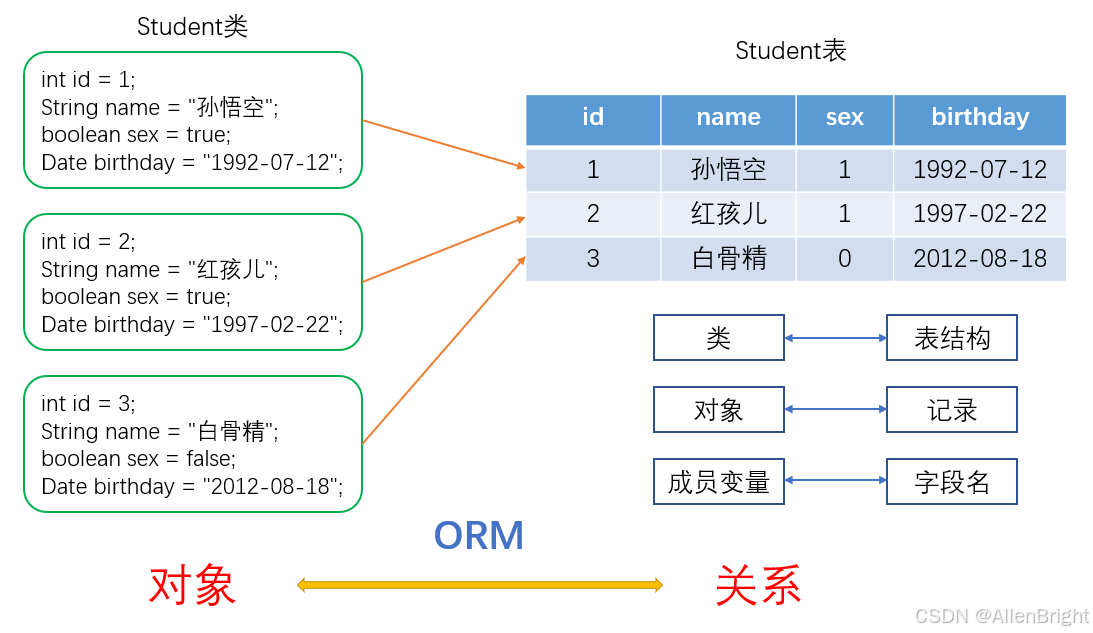在现代的java应用开发中,orm(object-relational mapping,对象关系映射)框架是不可或缺的一部分。mybatis作为一种灵活且强大的orm框架,因其能够直接操作sql语句而受到许多开发者的青睐。
1. mybatis简介
mybatis是一个持久层框架,它通过xml描述符或注解将java对象与数据库记录进行映射。与hibernate等全自动orm框架不同,mybatis允许开发者直接编写sql语句,从而提供了更高的灵活性和控制力。

2. mybatis的orm映射方式
mybatis的orm映射方式主要分为以下几种:
2.1 基于xml的映射
mybatis最初是通过xml文件来配置sql映射的。开发者可以在xml文件中定义sql语句、参数映射、结果映射等。
2.1.1 sql映射文件
<mapper namespace="com.allen.mapper.usermapper">
<select id="selectuser" resulttype="com.allen.model.user">
select id, username, password
from users
where id = #{id}
</select>
</mapper>在这个例子中,<select>标签定义了一个查询语句,id属性用于标识这个sql语句,resulttype属性指定了查询结果映射到的java对象类型。
2.1.2 参数映射
mybatis支持多种参数映射方式,包括简单类型、javabean、map等。
<select id="selectuserbyusername" resulttype="com.allen.model.user">
select id, username, password
from users
where username = #{username}
</select>在这个例子中,#{username}表示一个参数占位符,mybatis会自动将传入的参数值替换到sql语句中。
2.1.3 结果映射
结果映射是指将查询结果集映射到java对象的过程。mybatis提供了多种结果映射方式,包括自动映射、手动映射等。
<resultmap id="userresultmap" type="com.allen.model.user">
<id property="id" column="id"/>
<result property="username" column="username"/>
<result property="password" column="password"/>
</resultmap>
<select id="selectuser" resultmap="userresultmap">
select id, username, password
from users
where id = #{id}
</select>在这个例子中,<resultmap>标签定义了一个结果映射,<id>和<result>标签分别用于映射主键和普通字段。
2.2 基于注解的映射
随着java注解的流行,mybatis也提供了基于注解的映射方式,使得开发者可以在java代码中直接定义sql映射,而无需编写xml文件。
2.2.1 基本注解
public interface usermapper {
@select("select id, username, password from users where id = #{id}")
user selectuser(int id);
}在这个例子中,@select注解用于定义一个查询语句,#{id}表示一个参数占位符。
2.2.2 参数注解
mybatis注解方式也支持多种参数注解,如@param、@results等。
public interface usermapper {
@select("select id, username, password from users where username = #{username}")
user selectuserbyusername(@param("username") string username);
}在这个例子中,@param注解用于指定参数名称。
2.2.3 结果映射注解
mybatis注解方式也支持结果映射,通过@results和@result注解可以定义结果映射。
public interface usermapper {
@results({
@result(property = "id", column = "id"),
@result(property = "username", column = "username"),
@result(property = "password", column = "password")
})
@select("select id, username, password from users where id = #{id}")
user selectuser(int id);
}在这个例子中,@results注解用于定义结果映射,@result注解用于映射字段。
2.3 混合映射
mybatis允许开发者同时使用xml和注解进行映射,这种方式称为混合映射。开发者可以根据需要选择合适的映射方式。
public interface usermapper {
@select("select id, username, password from users where id = #{id}")
user selectuser(int id);
@select("select id, username, password from users where username = #{username}")
user selectuserbyusername(@param("username") string username);
@results({
@result(property = "id", column = "id"),
@result(property = "username", column = "username"),
@result(property = "password", column = "password")
})
@select("select id, username, password from users where id = #{id}")
user selectuserwithresultmap(int id);
}在这个例子中,selectuser和selectuserbyusername方法使用了注解映射,而selectuserwithresultmap方法使用了注解和结果映射。
3. mybatis映射的高级特性
3.1 动态sql
mybatis提供了强大的动态sql功能,允许开发者根据不同的条件生成不同的sql语句。
<select id="selectusers" resulttype="com.allen.model.user">
select id, username, password
from users
<where>
<if test="username != null">
and username = #{username}
</if>
<if test="password != null">
and password = #{password}
</if>
</where>
</select>在这个例子中,<where>标签和<if>标签用于生成动态sql语句。
3.2 关联映射
mybatis支持一对一、一对多、多对多等关联映射。
<resultmap id="userresultmap" type="com.allen.model.user">
<id property="id" column="id"/>
<result property="username" column="username"/>
<result property="password" column="password"/>
<association property="role" javatype="com.allen.model.role">
<id property="id" column="role_id"/>
<result property="name" column="role_name"/>
</association>
</resultmap>
<select id="selectuserwithrole" resultmap="userresultmap">
select u.id, u.username, u.password, r.id as role_id, r.name as role_name
from users u
join roles r on u.role_id = r.id
where u.id = #{id}
</select>在这个例子中,<association>标签用于映射一对一关联。
3.3 延迟加载
mybatis支持延迟加载,可以在需要时才加载关联对象,从而提高性能。
<resultmap id="userresultmap" type="com.allen.model.user">
<id property="id" column="id"/>
<result property="username" column="username"/>
<result property="password" column="password"/>
<association property="role" javatype="com.allen.model.role" select="selectrole" column="role_id" fetchtype="lazy"/>
</resultmap>
<select id="selectuserwithrole" resultmap="userresultmap">
select id, username, password, role_id
from users
where id = #{id}
</select>
<select id="selectrole" resulttype="com.allen.model.role">
select id, name
from roles
where id = #{role_id}
</select>在这个例子中,fetchtype="lazy"表示延迟加载。
4. 总结
mybatis作为一种灵活且强大的orm框架,提供了多种映射方式,包括基于xml的映射、基于注解的映射以及混合映射。开发者可以根据项目需求选择合适的映射方式,并通过动态sql、关联映射、延迟加载等高级特性进一步提升应用的性能和可维护性。
到此这篇关于mybatis orm映射方式详解的文章就介绍到这了,更多相关mybatis orm映射内容请搜索代码网以前的文章或继续浏览下面的相关文章希望大家以后多多支持代码网!







发表评论